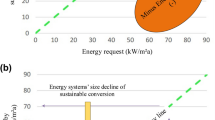Abstract
In this work, a multi objective optimization on roof layer thickness has been carried out through Taguchi based grey relational analysis technique. Conventional type of residential building roof was changed by a modified pattern of roof having layers namely concrete, phase change material, wood wool and weathering tile and its performance on heat insulation have been studied. In this study, the optimum thickness of roof layers was determined for minimum heat gain through roof by grey relational analysis technique. The thickness of various roof layers were considered as control parameters and varied through five levels of values. For this objective, Taghuchi’s L25 orthogonal array has been employed and the performance on heat insulation was studied through finite element analysis (FEA) technique. The FEA simulation on heat transfer across the roof has also been validated with the experimental results and found that it is having a good agreement. The optimized roof reduces the heat gain and temperature by 30 % and 3 °C respectively in comparison with the conventional type of roof. Also from this study, it was identified that the wood wool is the most predominant roof layer that controls the heat gain into the room.







Similar content being viewed by others
References
A. Pasupathy, R. Velraj, Energy and Buildings 40, 193 (2008)
A. Oliver, Energy and Buildings 48, 1 (2012)
C. Zhang, Y.Chen, L.Wu, M. Shi, Energy Build. 43 (2011)
A. V. Sáa, M. Azenhab, H. de Sousaa, A. Samagaioa, Energy Build. 49 (2012)
E. Wong. Reducing urban heat islands: Compendium of strateties- cool roofs. Tehcnical report, EPA (2008), http://www.epa.gov/hiri/resources/pdf/coolroofscompendium.pdf
H. Akbari, R. Levinson, Evoloution of cool-roof standards in the US. Advances in Building energy research. 2, 1–32 (2008)
Cool roof rating council (1998), http://www.coolroofs.org/index.html
F.U. Li, Grey Theory and its Application (Scientific and Technical Documents Publishing House, Beijing, 1992)
L.I.U. Si-feng, G.U.O. Tian-bang, D.A.N.G. Yao-guo, Grey System Theory and its Application (Science Press, Beijing, 1999)
D. Stephen, Zwanzig, Y. Lian, E.G. Brehob, Energy Convers. Manag. 69 (2013)
H.J. Alqallaf, E.M. Alawadhi, Energy Build. 61 (2013)
M. Ravikumar, P.S.S. Srinivasan, Eur. J. Sci. Res. 61–3 (2011)
K.C.K. Vijayakumar, P.S.S. Srinivasan, S. Dhandapani, J. Sci. Ind. Res. 65, (2006)
C.P. Kothandaraman, S. Subramanyan, Heat and mass transfer data book (New age international publisher, New Delhi, India, 2004)
N. Tosun, Int. J. Adv. Manuf. Technol. 28 (2006)
C.L. Chang, C.H. Tsai, L. Chen, Int. J. Comput. Internet. Manage. 11–3, (2003)
C.P. Fung, Wear. 254, (2003)
Author information
Authors and Affiliations
Corresponding author
Rights and permissions
About this article
Cite this article
Prakash, D., Ravikumar, P. Multi-Objective Optimization of Residential Building Roof Layer Thickness for Minimization of Heat Entering the Room Using FEM and Grey Relational Analysis. J. Inst. Eng. India Ser. A 95, 39–47 (2014). https://doi.org/10.1007/s40030-014-0071-1
Received:
Accepted:
Published:
Issue Date:
DOI: https://doi.org/10.1007/s40030-014-0071-1




